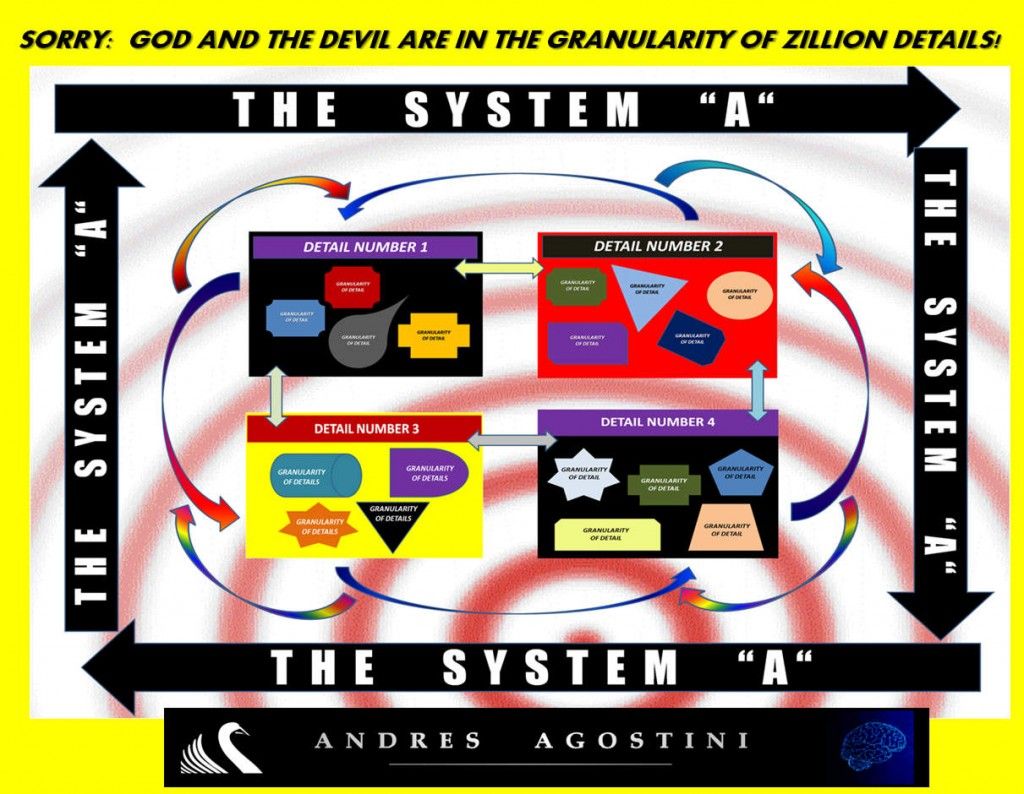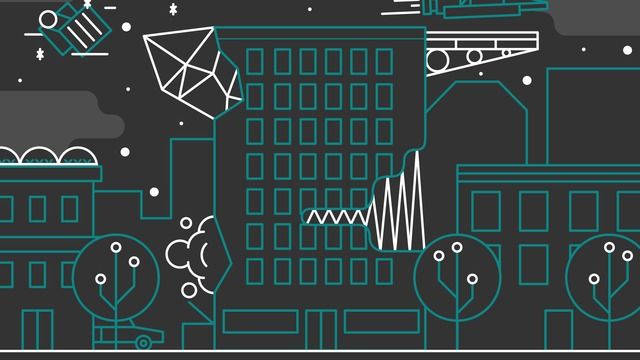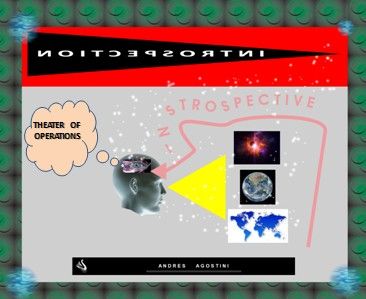Blitzkrieg Foresight!

Let us stop the universal guesswork to make decisions by ignoramuses of supine ignorance, beginning with the elitist “…intellectuals…”, specially those postdoctorals from the Ivy-league and Oxbridge.
You do not make (throughput to output) decisions to be instituted in the past, but in the Continual Present, whose Continuum is hugely connected to the Future.
ALL CONTAINED HERE IS A VERY BRIEF LITERAL EXCERPT OF ANDRES AGOSTINI’S WHITE SWAN BOOK:
LET US GET STARTED:
The American Heritage Dictionary’s Introduction (fourth edition, 2000) by Joseph P. Pickett, Executive Director, literally indicates, to further illustrate the reader, [54]:
“…This Fourth Edition of The American Heritage Dictionary combines the best of traditional making with key innovations that afford new ways of looking at our language… This edition has nearly 10,000 new words and senses that reflect the rapid pace of change in the English language today. Technological innovations in computing and communications along with advances in the sciences have been especially rich sources of development in the lexicon (for example, bit map, domain name, and raster in computing; dark matter, photonics, and yoctosecond in science). Medicine and medical research continue to produce an astonishing array of new terms for chemicals and substances (endostatin, leptin, transfatty acid), for disorders and infectious agents (Asperger’s syndrome, erectile dysfunction, hantavirus), for treatment (cocktail, molecular knife, xenotransplant), and for a variety of creations and discoveries (designer gene, enteric nervous system, microsleep) .… In addition, continuing social change in postindustrial society has given rise to expressions that describe new business practices (buyback, microcredit, reverse mortgage), a changing workplace (face time, job-share, mommy track), and evolving political positions and governmental policies (family leave, term limit, workfare). New sports terms have arisen (clap skate, five hole, skyboard), as have words for new educational practices (charter school, distance learning, homeschool). The names of foods from other cultures continue to be adopted (baba gannouj, garam masala, quesadilla). A host of new cultural developments has produced a host of new compound cords (assisted living, poetry slam, shock jock). And English speakers continue to be an exuberance force in creative coinage (bloviate, newbie, wannabe) .… To ensure accuracy in the coverage of our rapidly changing vocabulary, we have worked closely with distinguished consultants in a wide variety of specialized fields, including anthropology, astronomy, genetics, immunology, philosophy, and physics, to name but a few. We have also gone to great lengths to make our biological and geographic entries as timely as possible. Many new biographical entries have been added, especially in the areas of sports, music, film-making, and literature. To the geographic entries we have added new country names, such as Myanmar and the Republic of Congo, and newly prominent places such as Kosovo …”
AND ALSO FOR INSTANCE:
WHAT DO LUMINARIES SAY OF UTILITY HAVE TO SAY HERE?
ALSO #1 of #18:
Napoleon Bonaparte, to this end, asserted,
“…I have only one counsel for you — be master [.…] No longer it is question simply of education, NOW IT BECOMES A MATTER OF ACQUIRING [HARD] SCIENCE …” Brackets are of the author.
ALSO #2 of #18:
Dr. Carl Sagan, PhD. wrote,
“…We live in a society exquisitely dependent on science and technology, in which hardly anyone knows about science and technology…”
ALSO #3 of #18:
Prof. Bruce Bueno de Mesquita, PhD.,
“… We live in a high-tech age with archaic guesswork guiding life and death decisions …”
ALSO #4 of #15:
Harvard Business School professor Clay Christensen, Ph.D. indicated,
“… Change is hard, failure is much harder, and would you rather be sick or would you rather be dead?…”
ALSO #5 of #18:
In a June 2012 feature, Jeff Bezos told the Wall Street Journal:
“ … We humans have become so technologically sophisticated that in certain ways we’re dangerous to ourselves. It’s going to be increasingly important over time for humanity to take a longer-term view of its future …”
ALSO #6 of #18:
Jacob Bronowski advised,
“ … We are a scientific civilization .… that means a civilization in which knowledge and its integrity are crucial. Science is only a Latin word for [organized] knowledge .… knowledge is our destiny …”
OTHER STUPIDS, DO THEY NOT UNDERSTAND THIS?:
(1.-) “.. Science…” is Organized Knowledge.
(2.-) “… Wisdom …” is Organized Life.
ALSO #7 of #18:
Professor Stephen Hawking, Ph.D. warned,
” … Mankind must colonize other planets to survive [….] THE LONG-TERM SURVIVAL OF THE HUMAN RACE IS AT RISK AS LONG AS IT IS CONFINED TO A SINGLE PLANET [.…] SOONER OR LATER, DISASTERS SUCH AS AN ASTEROID COLLISION OR NUCLEAR WAR COULD WIPE US ALL OUT. BUT ONCE WE SPREAD OUT INTO SPACE AND ESTABLISH INDEPENDENT COLONIES, OUR FUTURE SHOULD BE SAFE [….] There isn’t anywhere like the Earth in the solar system, so we would have to go to another star […] The primitive forms of artificial intelligence we already have, have proved very useful. But I think the development of full artificial intelligence could spell the end of the human race [….] We are pushing the boundaries of what is possible through technology – without it I would not be able to speak to you today …”
ALSO #8 of #18:
FINANCIAL TIMES (December 2, 2014, 6:13 pm) posits,
“ … Prof. Stephen Hawking warns on rise of the machines … The astrophysicist Stephen Hawking has warned that artificial intelligence ‘could outsmart us all’ and is calling for humans to establish colonies on other planets to avoid ultimately a ‘near-certainty’ of technological catastrophe … ’ … By contrast, according to Moore’s Law, computers double their speed and memory capacity every 18 months. The risk is that computers develop intelligence and take over. Humans, who are limited by slow biological evolution, couldn’t compete, and would be superseded,’ he said … Both PayPal co-founder Peter Thiel and Elon Musk, the entrepreneur behind the electric car Tesla and SpaceX, the private space flight company, have warned of the dangers of complacency over the consequences of unconstrained advances in artificial intelligence … Google is making a push into ‘…quantum computing …’ and has established an ethics committee to monitor the work of DeepMind, the artificial intelligence start-up it bought for £400m (US$625.84) earlier in the year. Consumers are coming into increasing contact with “smart” machines, including flying drones and prototypes of self-driving cars … A recent paper from researchers at the Oxford Martin School at Oxford university has warned governments to plan for the risk of ‘robo-wars’ in which autonomous weapons can identify and decide to kill targets without human intervention … But he also warned that there was potentially a more destructive element to technology. ’ … We face a number of threats to our survival, from nuclear war, catastrophic global warming, and genetically engineered viruses; the number is likely to increase in the future, with the development of new technologies, and new ways things can go wrong, …’ he said. … ’ … We need to expand our horizons beyond planet Earth if we are to have a long-term future, spreading out into space, and to other stars, so a disaster on Earth would not mean the end of the human race. Establishing self-sustaining colonies will take time and effort, but it will become easier as our technology improves …’ …” FINANCIAL TIMES at https://lnkd.in/eB2Mn8z
ALSO #9 of #18:
Albert Einstein observed,
“ … It has become appallingly obvious that our technology has exceeded our humanity …”
ALSO #10 of #18:
Cambridge University’ Sir Martin Rees, Ph.D. (British Astronomer Royal) noticed,
“ … Science is emphatically not, as some have claimed, approaching its end; it is surging ahead at an accelerating rate. We are still flummoxed about the bedrock nature of physical reality, and the complexities of life, the brain, and the cosmos. New discoveries, illuminating all these mysteries, will engender benign applications; but will also pose NEW ETHICAL DILEMMAS AND BRING NEW HAZARDS …. BUT THERE IS A DARK SIDE: NEW SCIENCE CAN HAVE UNINTENDED CONSEQUENCES; IT EMPOWERS INDIVIDUALS TO PERPETRATE ACTS OF MEGATERROR; EVEN INNOCENT ERRORS COULD BE CATASTROPHIC. THE ‘DOWNSIDE’ FROM TWENTY-FIRST CENTURY TECHNOLOGY COULD BE GRAVER AND MORE INTRACTABLE THAN THE THREAT OF NUCLEAR DEVASTATION THAT WE HAVE FACED FOR DECADES. AND HUMAN-INDUCED PRESSURES ON THE GLOBAL ENVIRONMENT MAY ENGENDER HIGHER RISKS THAT THE AGE-OLD HAZARDS OF EARTHQUAKES, ERUPTIONS, AND ASTEROID IMPACTS …”
ALSO #11 of #18:
Charles, Prince of Whales, observed:
“ … The strategic threats posed by global environment and development problems are the most complex, interwoven and potentially devastating of all the challenges to our security. Scientists …. do not fully understand the consequences of our many-faceted assault on the interwoven fabric of atmosphere, water, land and life in all its biological diversity. Things could turn out to be worse than the current scientific best guess. IN MILITARY AFFAIRS, POLICY HAS LONG BEEN BASED ON THE DICTUM THAT WE SHOULD BE PREPARED FOR THE WORST CASE. WHY SHOULD IT BE SO DIFFERENT WHEN THE SECURITY IS THAT OF THE PLANET AND OUR LONG-TERM FUTURE? …” [229]
ALSO #12 of #18:
Prof. Daniel Berleant, Ph.D. observes,
“… Will we destroy ourselves in a matter of years, decades, or centuries, or will we last indefinitely? Many people see our increasing power over nature, coupled with self-destructive tendencies, leading us to destroy ourselves [.…] Perhaps we will transcend both technology-enabled self-destruction and normal evolution …”
ALSO #13 of #18:
And a Sephardi Hebrew, gave me an Arab adage that argues,
“… The one who foretells the future correctly, lies even if he is telling the truth …”
ALSO #14 of #18:
However, as a counterpoint Lockheed Martin argues:
“… What’s impossible today won’t be tomorrow …”
ALSO #15 of #18:
Subsequently, the hugely-ignored Chinese proverb indicates,
“…Don’t look at the waves but the currents underneath…”
ALSO #16 of #18:
Nevertheless, the Panchatantra (body of Eastern philosophical knowledge) establishes,
“… Knowledge is the true organ of sight, not the eyes … ”
ALSO #17 of #18:
And Antonio Machado argues,
“… An eye is not an eye because you see it; an eye is an eye because it sees you …”
ALSO #18 of #18:
Prof. Michio Kaku, Ph.D. indicates,
“… By the end of the twentieth century, science had reached the end of an era, unlocking the secrets of the atom, unraveling the molecule of life, and creating the electronic computer. With these three fundamental discoveries, triggered by the quantum revolution, the DNA revolution, and the computer revolution, the basic laws of matter, life, and computation were, in the main, finally solved .… That epic phase of science is now drawing to a close; one era is ending and another is only beginning .… The next era of science promises to be an even deeper, more thoroughgoing, more penetrating one than the last .… Clearly, we are on the threshold of yet another revolution. HUMAN KNOWLEDGE IS DOUBLING EVERY TEN YEARS [AS PER THE 1998 STANDARDS]. In the past decade, more scientific knowledge has been created than in all of human history. COMPUTER POWER IS DOUBLING EVERY EIGHTEEN MONTHS. THE INTERNET IS DOUBLING EVERY YEAR. THE NUMBER OF DNA SEQUENCES WE CAN ANALYZE IS DOUBLING EVERY TWO YEARS. Almost daily, the headlines herald new advances in computers, telecommunications, biotechnology, and space exploration. In the wake of this technological upheaval, entire industries and lifestyles are being overturned, only to give rise to entirely new ones. But these rapid, bewildering changes are not just quantitative. They mark the birth pangs of a new era .… FROM NOW TO THE YEAR 2020, SCIENTISTS FORESEE AN EXPLOSION IN SCIENTIFIC ACTIVITY SUCH AS THE WORLD HAS NEVER SEEN BEFORE. IN TWO KEY TECHNOLOGIES, COMPUTER POWER AND THE DNA SEQUENCING, WE WILL SEE ENTIRE INDUSTRIES RISE AND FALL ON THE BASIS OF BREATHTAKING SCIENTIFIC ADVANCES. SINCE THE 1950S, THE POWER OF OUR COMPUTERS HAS ADVANCED BY A FACTOR OF ROUGHLY TEN BILLION. IN FACT, BECAUSE BOTH COMPUTER POWER AND DNA SEQUENCING DOUBLE ROUGHLY EVERY TWO YEARS, ONE CAN COMPUTE THE ROUGH TIME FRAME OVER WHICH MANY SCIENTIFIC BREAKTHROUGHS WILL TAKE PLACE .… BY 2020, MICROPROCESSORS WILL LIKELY BE AS A CHEAP AND PLENTIFUL AS SCRAP PAPER, SCATTERED BY THE MILLIONS INTO ENVIRONMENT, ALLOWING US TO PLACE INTELLIGENT SYSTEMS EVERYWHERE. THIS WILL CHANGE EVERYTHING AROUND US, INCLUDING THE NATURE OF COMMERCE, THE WEALTH OF NATIONS, AND THE WAY WE COMMUNICATE, WORK, PLAY, AND LIVE…” [171]
SIGNIFICANTLY AS WELL, TO BE BARED IN MIND:
British people insist that as per the Rosicrucian Englishmen, Shakespeare was really Francis Bacon. Having said that, and coming back to the hard-core subject, Sir Francis Bacon (1561 −1626) wrote,
“… Men have abandoned universality [of knowledge], or philosophia prima, which cannot but cease and stop all progression [pursued through arbitrarily established specialization and even super-specialization]. For no perfect discovery can be made upon a flat or a level; neither is possible to discover the more remote and deeper parts [, both subtle and dramatic,] of any science if you stand but upon the level of the same science, and ascend not to a higher science [towards true non-theological omniscience] …” Brackets of the Author.
CONCLUSION:
Austrian-American Peter Ferdinand Drucker (ISBN: 978–0060851149) strongly argues, as I have verified in my 33-year-old continual evidence-based research, that people’s schemas (understandings of the world), belief systems, worldviews, and most cherished notions and truisms, as well as Weltanschauungs, have a median and in average — as per the 1990’s standards — of twenty (20) years of obsolescence per each person. This obsolescence is insanely grave for the viability of Earth.
Factual proof, available and to the possession of this Author, strongly indicates that such obsolescence has exponentially widened with the elapse of time while technological breakthroughs and scientific discoveries are more prevalent and obvious.
If you don’t understand this, get ready to be Strategically Surprised beyond your most-colossal nightmares. Something(s) seismic and tectonic FORCES will happen globally between 2014 and early 2016. You have been warned!
To-this-end details are to be found in the White Swan book. The reader has seen 0.001% of such a book.
HOWEVER, THERE IS FUNDAMENTAL COPING AVAILABLE FOR THE ONE PAYING ATTENTION. SAID COPING MUST BE INSTITUTED BEFORE THE FACTS, NOT AFTER THE FACTS. I CAN HELP!
ABSOLUTE END.
Authored By Copyright Mr. Andres Agostini
White Swan Book Author (Source of this Article)
http://www.LINKEDIN.com/in/andresagostini
http://www.AMAZON.com/author/agostini
https://www.FACEBOOK.com/agostiniandres
http://www.appearoo.com/aagostini
http://connect.FORWARDMETRICS.com/profile/1649/Andres-Agostini.html
@AndresAgostini
@ThisSuccess
@SciCzar
N.B.: IT IS ARGUED IN MY LINKEDIN PROFILE MY GARGANTUANEST INCLINATION IN WOMB-TO-TOMB THINKING THROUGH SYSTEMS APPROACH AND THE NON-THEOLOGICAL OMNISCIENCE PERSPECTIVE.







